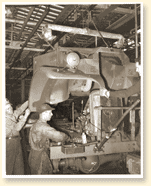

Workers assembling military truck at the plant of Ford Motor Company of Canada, Windsor, Ont., November 1940.
Photo : National Film Board |
The War Economy and Controls: Munitions
The federal government established the Department of Munitions and
Supply in April 1940 to control the production of munitions for
Canada and its . C.D. Howe was its political head; he led and
others, inspired, followed. He and his department not only equipped
Canada's armed forces but also got orders from outside the country,
chiefly from Britain, controlled the raw materials needed to make
munitions, and even created out of nothing whole new industries to
manufacture them. By 1945 Canada's war production was fourth among the Allied nations,
less only than that of the United States, the Soviet Union and the
United Kingdom. Only some 30% of this was needed for Canada's armed
forces: the remainder went overseas (see aircraft
production and shipping and shipbuilding). Another of the most important was the
mass production of 815,729 military vehicles, including 45,710
armoured vehicles. Canadian-made vehicles were crucial in equipping
the British Eighth in North
Africa and Italy. Canada also
produced rifles, submachine guns, light machine guns, antitank guns
and antiaircraft guns, as well as the multipurpose 25-pounder
artillery piece. The term "munitions" no longer meant just the weapons and equipment
used by troops. It now often was used to include a whole range of
manufactured goods used in making war. Related Newspaper Articles
English Articles
- Richer Canada More Prepared as Supply Unit
The Globe and Mail, 12/10/1939
- Careful Attention is Given Gigantic Task of Supplying Vital Needs For War Effort
The Hamilton Spectator, 30/08/1940
- Some Things Canada's Done In This War
The Toronto Daily Star, 05/07/1941
- Dominion's Output of Munitions, Arms and Equipment Reaches Amazing Totals as Busy Workers Step Up Ceaseless Production to Bring Downfall of Enemies
The Hamilton Spectator, 19/12/1942
- Secret Devices Made in Canada
The Hamilton Spectator, 19/12/1942
- Every Week, This Is What 900,000 Canadian Men and Women Produce for War Fronts of World
The Globe and Mail, 12/06/1943
- Canadian Munitions Serve the United Nations / Canadian War Goods Help Allies Everywhere
The Globe And Mail, 12/06/1943
- Vast Canadian Depot Supplies War Fronts
The Globe And Mail, 22/03/1944
French Articles
-
Les commandes de guerre
Le Devoir, 25/01/1940
-
Contrats de guerre
Le Devoir, 25/03/1940
-
Pour faire des munitions
Le Devoir, 26/03/1940
-
Les commandes de guerre au Canada
Le Devoir, 23/05/1940
-
La fabrication de munitions au Canada
Le Devoir, 30/05/1940
-
Pour les industries de guerre
Le Devoir, 04/01/1941
-
Nouveau contrat pour la bren
Le Devoir, 10/01/1941
-
Mortiers de 3 pouces
Le Devoir, 17/03/1941
-
De l'acier pour la guerre
Le Devoir, 19/05/1941
-
Pour la guerre. 30$ millions par mois
Le Devoir, 24/05/1941
-
Le recrutement. "Ouvrier indispensable"
Le Devoir, 26/05/1941
-
Tubes de canons antiaériens. Leur fabrication au Canada
Le Devoir, 07/06/1941
-
"Inauguration des premiers canons à obus de 25 livres sortis des vastes usines des 'Sorel Industries'"
Le Devoir, 02/07/1941
-
"3,000 camions"
Le Devoir, 16/01/1942
-
Le rôle des usines de guerre
Le Devoir, 21/01/1942
-
Les employés dans les industries de guerre
Le Devoir, 20/03/1942
-
Canadian Industries
Le Devoir, 23/03/1942
-
"Nos forces armées et nos industries de guerre auront besoin de 250,000 hommes d'ici cinq mois"
Le Devoir, 13/07/1942
-
Grenade sous-marines fabriquées au Canada
Le Devoir, 13/07/1942
-
Nouvelles de guerre. Notre production de canons
Le Devoir, 24/09/1942
|